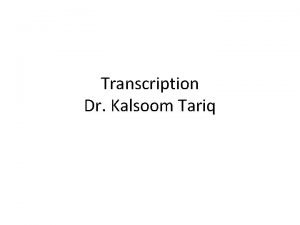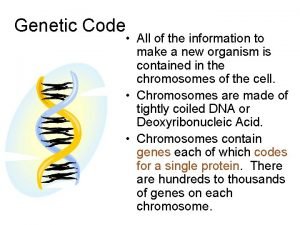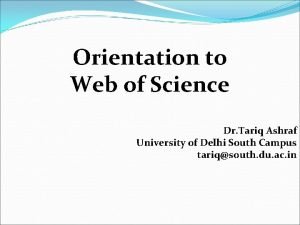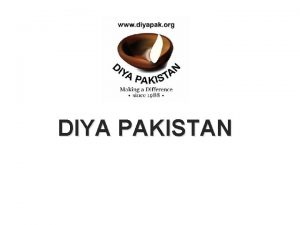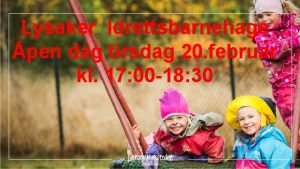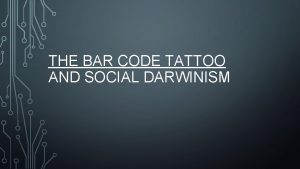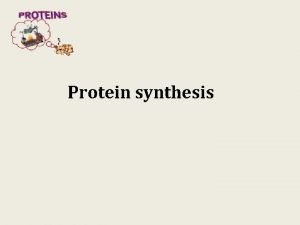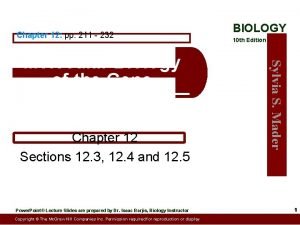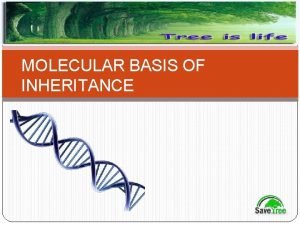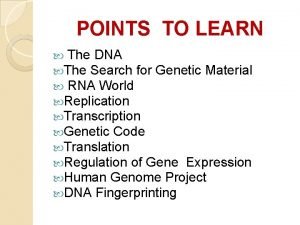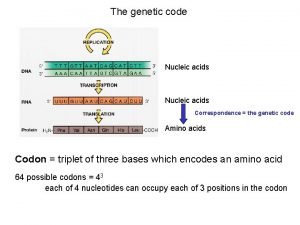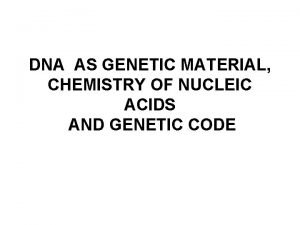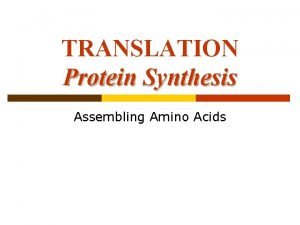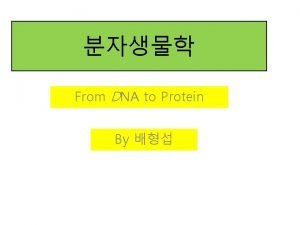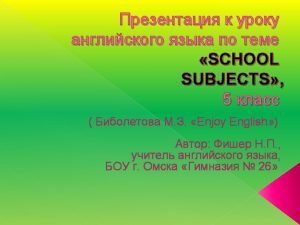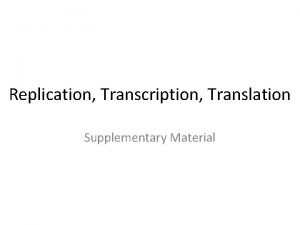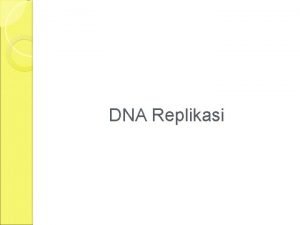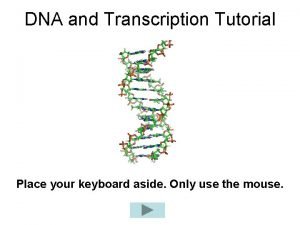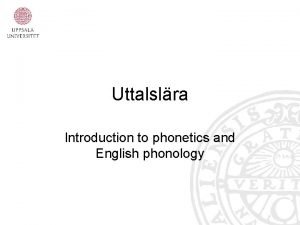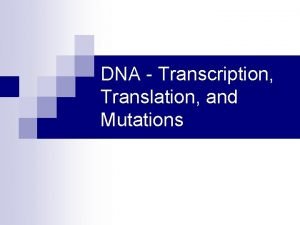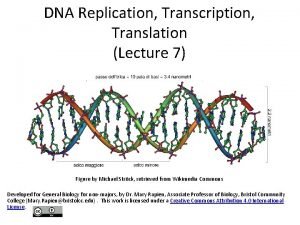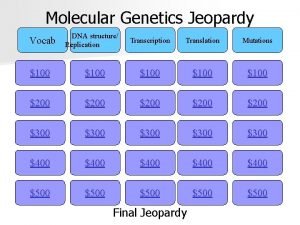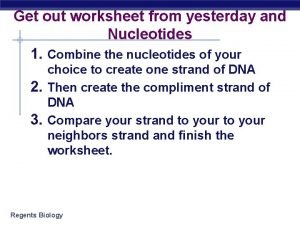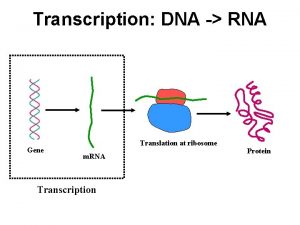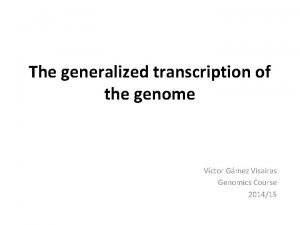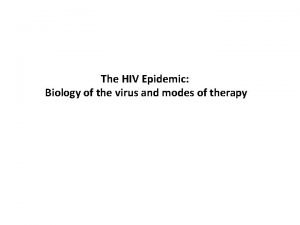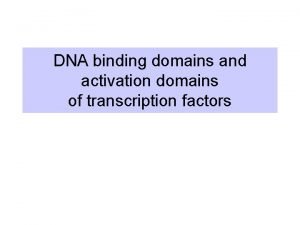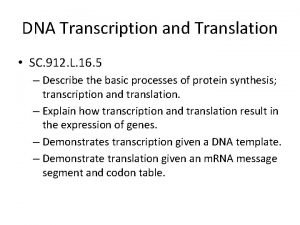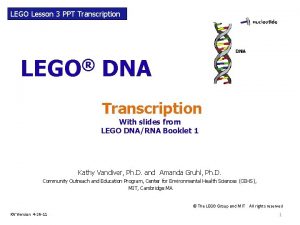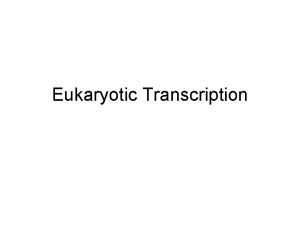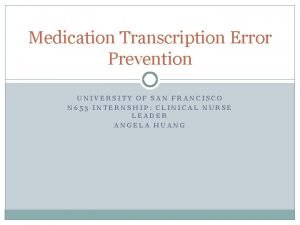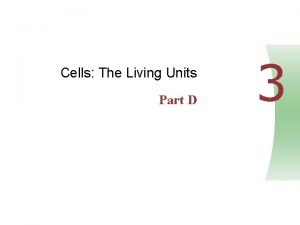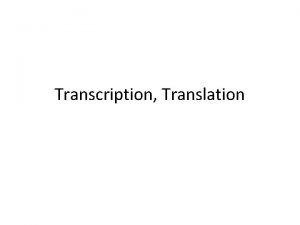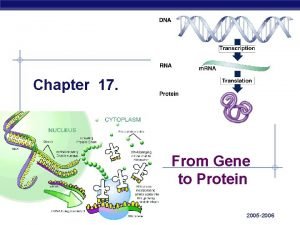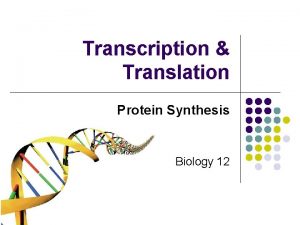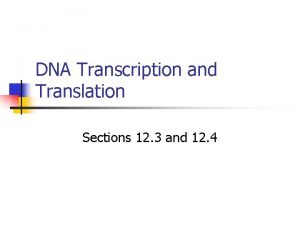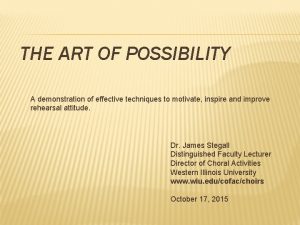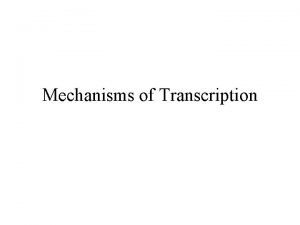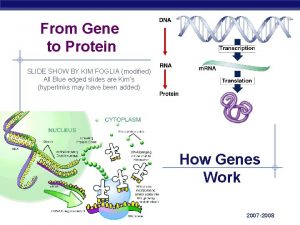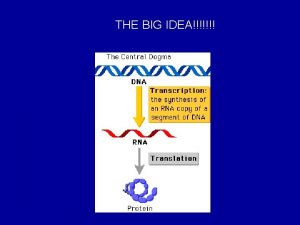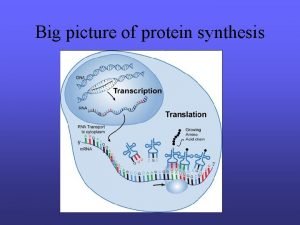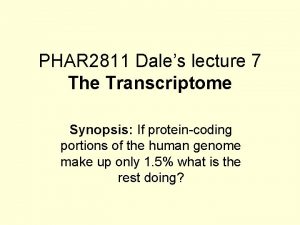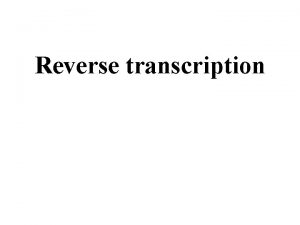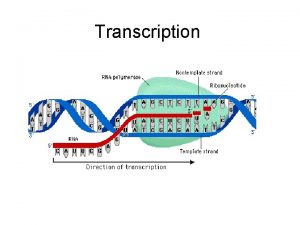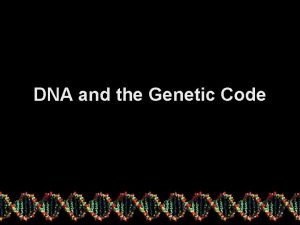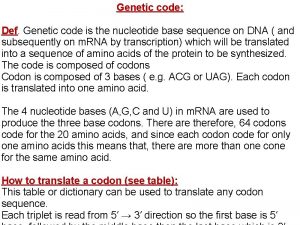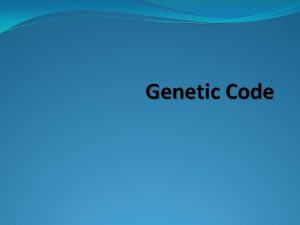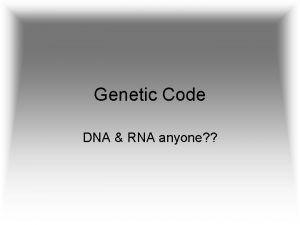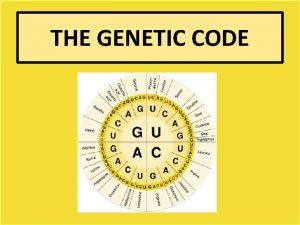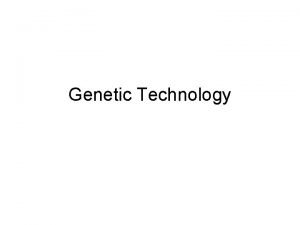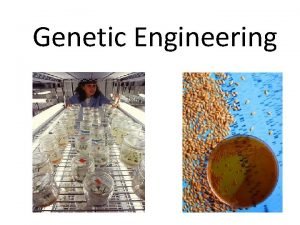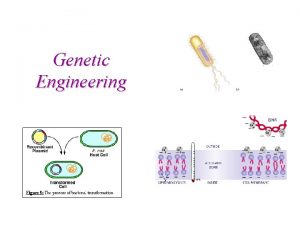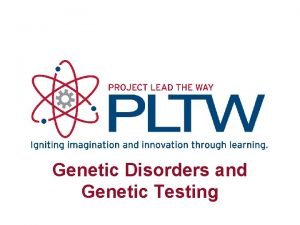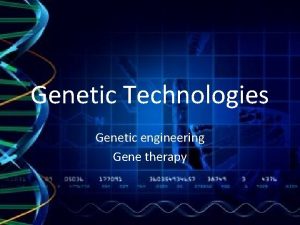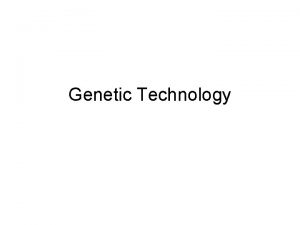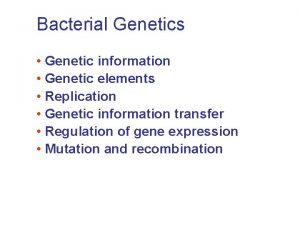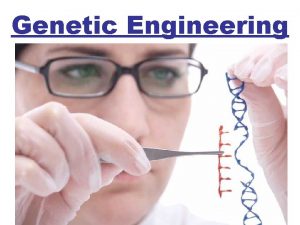Transcription Dr Kalsoom Tariq The Genetic code The



























































- Slides: 59

Transcription Dr. Kalsoom Tariq

The Genetic code • The genetic code is a dictionary that identifies the correspondence between a sequence of nucleotide bases and a sequence of amino acids • Each individual word in the code is composed of three nucleotides bases • These genetic words are called codons. 2

• Codons are presented in the m. RNA language of adenine (A), Guanine (G), Cytosine (C) and Uracil (U) • The four nucleotide bases produce 64 different combinations of three base codons • The nucleotide sequence of codon on m. RNA is written from 5’ to 3’ end • 61 codons code for 20 amino acids found in protein. 3

copyright cmassengale 4

Non Sense Codon • Three of the codons, UAG, UGA and UAA do not code for amino acids and are called termination codon • When one of these codons appear in m. RNA sequence, it signals synthesis of the protein coded for by that m. RNA is completed • AUG codes for methionine which is the first amino acid in the poly peptide , known as the start codon. 5

Characteristics of Genetic Code • • • Specificity (unambiguity) Universality Degeneracy Non overlapping Comma less ness 6

Specificity • A particular codon always codes for the same amino acid • For example: UGG is a code specified for Tryptophan 7

Universality • The same codons are used to code for the same amino acids in all living organisms. • Thus genetic code has been conserved during the course of evolution. • Exception to universality is found in mitochondrial genome where ‘AUA’ codes for methionine instead of isoleucine & UGA for tryptophan instead of stop codon. 8

Degeneracy • Degeneracy means having multiple domain elements corresponding to one element. • Most of the amino acids have more than one codon • The codon is degenerate since there is 61 codons for 20 amino acids • The codons that designate the same amino acids are called synonyms. 9

Degeneracy • Often the base of the third position is insignificant meaning the codons representing the same amino acid differ in the third base , e. g; UCU, UCC, UCA, UCG all code for serine. • The reduced specificity of the last position is known as “third base degeneracy or wobbling phenomenon”. • This feature minimizes the effects of mutations.

Non-overlapping • All codons are independent set of 3 bases, read from a fixed point as a continuous base sequence. • There is non-overlapping, i. e. no base functions as a common member of two consecutive codons. • For example: UUUCUUAGA is read as UUU/CUU/AGA/ • Addition or deletion of one or two bases will change the message sequence in m. RNA 11

Comma less ness • Codons are arranged in a continuous structure. • There is not one or more nucleotides between consecutive codons. • The last nucleotide of preceding codon is immediately followed by the first nucleotide of the succeeding nucleotide.

Consequences of Altering the Nucleotide sequence • • • Changing a single nucleotide base on the m. RNA chain results in any one of the following mutation. A. Point mutations B. Frame shift mutations Point mutations can either be 1. Transitions 2. Transversions , which can be further subdivided into Silent mutation Mis sense mutation Nonsense mutation copyright cmassengale 13

Silent Mutation • means (no detectable effect). • The codon containing the changed base may code for the same amino acid. • For example: if serine codon UCA is given a different third base-U-to become UCU, it still codes for serine. Therefore it is termed as ‘silent mutation’ 14

Missense Mutation • The codon containing the changed base may code for different amino acid • For example: if serine codon UCA is given a different first base-C-to become CCA , it will code for different amino acid that is proline. • The substitution of incorrect amino acid is called mis sense mutation copyright cmassengale 15

Nonsense Mutation • The codon containing the changed base may become a termination codon. • For example: if serine codon UCA is given a different second base-A-to become UAA, the new codon causes the termination of translation at that point. • The creation of termination codon at an inappropriate place is called nonsense mutation. 16

Other Mutation • These can alter the amount or structure of protein produced by translation • Tri nucleotide repeat expansion • Splice site mutation • Frame-shift mutation 17

Trinucleotide repeat expansion • Occasionally the sequence of three bases become amplified in number so that many copies of the triplet occur. • If this occur in the coding region of a gene, the protein will contain many extra copies of one amino acid • Eg; Amplification of CAG codon leads to the insertion of many extra glutamine residues in huntington protein causing the neuro-generative disorder Huntington disease 18

Splice Site Mutation • Mutations at splice sites can change the way in which introns are removed from pre m RNA molecules, which can produce abnormal protein. 19

Frame-Shift Mutation • Two types, Deletion type or Insertion type • If one or two nucleotide is either deleted from or added to the interior of a message sequence, a frame-shift mutation occurs and the reading frame is altered • The resulting amino acid sequence may become different from this point • If three nucleotides are added or deleted from the strand, the reading frame is not affected 20

copyright cmassengale 21

copyright cmassengale 22

• • • Mechanisms of Repair Several methods are available. They are: A. Excision repair B. Photo reactivation C. Recombinational repair D. Mismatch repair.

• Photo reactivation: Also called light induced repair. • The enzyme photo reactivating (PR) enzyme brings about • an enzymatic cleavage of thymine dimers activated by • the visible light (300 -600 mµ) leading to a restoration of

• Recombinational Repair • Also called as sister-strand exchange. • In this process, the unmutated single stranded segment from homologous DNA is excised from the“good”strand inserted into the “gap” opposite the dimer. • It occurs after the first round of DNA replication. • Mismatch Repair of DNA • Mismatch repair corrects errors made when DNA is copied. • Mechanism: This mechanism corrects a single mismatch base pair, e. g. C to A rather than T to A or a short region of unpaired DNA. The defective region is recognised by an endonuclease

Transcription • Transcription is the process in which ribonucleic acid (RNA) is synthesized from DNA • For this purpose, one of the two strands of DNA serves as a template to produce working copies of RNA molecules 26

Transcription is Selective • The entire molecule of DNA is not expressed in transcription • RNA are synthesized only for some selected regions of DNA • The product formed in transcription is referred to as primary transcript • The primary transcript is inactive. They undergo post transcriptional modification to produce functionally active RNA molecules 27

Transcription • A single enzyme DNA dependent RNA polymerase or simply RNA polymerase is responsible for transcription • RNA polymerase is a complex holoenzyme with five polypeptide units__ 2 a, 1 b and 1 b / and 1 s factor • The enzyme with out a sigma factor is called a core enzyme • And with a core enzyme is called Holo enzyme 28

copyright cmassengale 29

Steps of Transcription involves three different stages: • Formation of transcription complex • Initiation • Elongation • Termination 30

Initiation • The binding of the enzyme RNA polymerase is prerequisite for the transcription to start • The specific region on the DNA where the enzyme binds is known as promoter region • There are two base sequences on the coding DNA strand which the sigma factor of RNA polymerase can recognize for initiation of transcription 31

Pribnow Box • This consist of 6 nucleotide bases (TATAAT) located on the left side about 10 bases away (upstream) from the starting point of transcription • The T at position 6 is present in every promotor region of pribnow box & is known as (conserved T). 32

The ‘---35’ sequence • This is the second recognition site in the promoter region of DNA • It contains a base sequence TTGACA, which is located about 35 bases away on the left side from the site of transcription started. • It is thought to be the initial site of sigma subunit binding, it contains upto nine bases. 33

The ‘---35’ sequence • This is the second recognition site in the promoter region of DNA • It contains a base sequence TTGACA, which is located about 35 bases away on the left side from the site of transcription started 34

Elongation • As the holo enzyme, RNA polymerase recognizes the promoter region, the sigma factor is released and transcription proceeds • RNA is synthesized from 5’ to 3’ direction, anti parallel to DNA template • RNA polymerase utilizes ribonucleotide triphosphates ( ATP, GTP, CTP and UTP) for the formation of RNA 35

Elongation • The sequence of nucleotide bases in the m. RNA is complementary to the template DNA strand. It is however, identical to the coding strand except that RNA contains U in place of T in DNA 36

Elongation • RNA polymerase differs from DNA polymerase in two aspects. • 1)No primer is required • 2)RNA polymerase do not have endo and exonuclease activity and also do not have proof reading activity • RNA polymerase has no ability to repair the mistakes in the RNA synthesized in contrast to DNA replication which is carried out with high fidelity 37

Elongation • It is however fortunate that mistakes in RNA synthesis are less dangerous, since they are not transmitted to the daughter cells • The double helical structure of DNA unwinds as the transcription goes on, resulting in super coils • The problem of super coils is overcome by topo isomerase. • The DNA helix recloses after RNA polymerase transcribes through it & the growing RNA chain dissociates from it. 38

Termination Two types of termination are identified • Rho dependent termination • Rho independent termination 39

Rho Dependent Termination • A specific protein, named rho factor, binds to the growing RNA , and terminates transcription and release RNA • The Rho factor is also responsible for the dissociation of RNA polymerase from DNA 40

Rho Dependent Termination 41

Rho Independent Termination • This requires that a sequence in template DNA generates a sequence in RNA which is self complementary • This allows the RNA to fold back on itself, forming GC rich stem plus loop. This structure is known as hairpin • Beyond the hairpin the RNA transcript contain a string of Uracils • The bonding of Us with Adenines of DNA is weak and thus RNA strand splits out 42

43

Transcription in Eukaryotes • RNA synthesis in eukaryotes is a much more complicated process than the transcription described in prokaryotes • The difference in the eukaryotic transcription occurs in • RNA polymerases • Promoter Sites • Initiation step 44

Eukaryotic RNA Polymerases • The nuclei of eukaryotic cells possess three distinct RNA polymerases • RNA polymerase I: responsible for the synthesis of ribosomal RNA • RNA polymerase II: responsible for the synthesis of messenger RNA • RNA polymerase III: responsible for the synthesis of transfer RNA 45

Promoter Sites • In eukaryotes three different promotor regions are identified • Hogness box: also called TATA box, located on the left about 25 nucleotide away from the starting site of m. RNA synthesis • CAAT box: it is located to the left, 80 bases away from the starting site of m. RNA synthesis • GC region: 100 bases towards the left upstream from the starting site of m. RNA synthesis. 46

Promoter Sites 47

Initiation of Transcription • The molecular events required for the initiation of transcription in eukaryotes are complex and broadly involve three stages • Attachment of sigma factor of RNA polymerase II to the promoter region • Binding of transcription factor (TFs) to the promotor region • Attachment of enhancer to the promoter region and thus increasing the gene expression by 100 folds 48

Transcription factors • TF are a very diverse family of proteins & generally function in multi subunit protein complexes. They may bind directly to the special “promotor “ region or directly to the RNA Polymerase molecule. • Their function is to initiate & regulate the transcription of genes.

copyright cmassengale 50

Heterogeneous Nuclear RNA (hn. RNA) • The primary m. RNA transcript produced by RNA polymerase II in eukaryotes is often called heterogeneous nuclear RNA (hn. RNA) • It is the precursor of m. RNA& is in inactive form. 51

Post Transcriptional Modification • The RNAs produced during transcription are called primary transcript. They undergo many alterations, terminal base additions, base modifications and splicing. • These alterations are collectively called posttranscriptional modifications • This process is required to convert the RNAs into active form • Ribo nucleases are responsible for post transcriptional modifications 52

Post Transcriptional Modification • The primary transcript of m. RNA is hn RNA in eukaryotes, which is subjected to many changes before functional m. RNA is produced • 5’ capping • Poly A tail • Removal of Introns 53

The 5’ Capping • The 5’ end of m. RNA is capped with 7 -methyl guanosine produced by S-Adenosylmethionine + GTP. • This group is required for translation, besides stabilizing the structure of m. RNA 54

Poly A tail • A large number of eukaryotic m. RNAs possess an adenine nucleotide chain at the 3’ end. • This poly A tail, as such, is not produced during transcription. • It is later added to stabilize m. RNA 55

Poly A tail • A large number of eukaryotic m. RNAs possess an adenine nucleotide chain at the 3’ end. • This poly A tail, as such, is not produced during transcription. • It is later added to stabilize m. RNA 56

Removal of Introns • Introns are the intervening nucleotide sequence in m. RNA which do not code for protein • Exons of m. RNA possess genetic code and are responsible for protein synthesis • The removal of introns are promoted by small nuclear ribo nuclear protein particles (Sn. RNPs) 57

Removal of Introns 58

Inhibitors of Transcription • Actinomycin D: It binds with DNA template strand blocks the movement of RNA polymerase. It is widely used in the treatment of tumors • Rifamycin: It binds to the beta subunit of RNA polymerase and inhibits activity • Amantin: It tightly binds to the RNA polymerase II in eukaryotes and stops the transcription process • Heparin: It binds to the beta subunit & inhibits transcription in vitro. 59
 Rho factor
Rho factor Trace the code genetic code table
Trace the code genetic code table Founders effect
Founders effect Genetic drift vs genetic flow
Genetic drift vs genetic flow Genetic programming vs genetic algorithm
Genetic programming vs genetic algorithm Genetic programming vs genetic algorithm
Genetic programming vs genetic algorithm A gene pool consists of
A gene pool consists of Imtashal tariq
Imtashal tariq Tariq salameh
Tariq salameh Dr tariq ashraf
Dr tariq ashraf Diya pakistan scholarship
Diya pakistan scholarship Telle tariq
Telle tariq Busceral
Busceral Social darwinism
Social darwinism Genetic code table
Genetic code table Mrna
Mrna Properties of genetic code
Properties of genetic code Rho factor
Rho factor Salient features of genetic code
Salient features of genetic code Genetic code
Genetic code Codon function
Codon function Dehydration synthesis of amino acids
Dehydration synthesis of amino acids Transcription
Transcription Bbc bitesize protein synthesis
Bbc bitesize protein synthesis Odd phonetic transcription
Odd phonetic transcription Transcription and translation
Transcription and translation Transcription translation replication
Transcription translation replication Reverse transcription
Reverse transcription Transcription city
Transcription city Dna and transcription tutorial
Dna and transcription tutorial Arthur the rat phonetic transcription
Arthur the rat phonetic transcription Dna transcription
Dna transcription Replication transcription translation
Replication transcription translation Jeopardy transcription
Jeopardy transcription Transcription and translation practice worksheet answer key
Transcription and translation practice worksheet answer key Dna to rna transcription
Dna to rna transcription Transcription
Transcription Where did hiv come from
Where did hiv come from Cot phonetic transcription
Cot phonetic transcription Activation domain of transcription factors
Activation domain of transcription factors Dna transcription
Dna transcription Dna construct
Dna construct Eukaryotic transcription
Eukaryotic transcription Prokaryotic cell vs eukaryotic cell
Prokaryotic cell vs eukaryotic cell Prokaryotes vs eukaryotes venn diagram
Prokaryotes vs eukaryotes venn diagram Transcription error
Transcription error Dna to rna transcription
Dna to rna transcription Transcription and translation coloring
Transcription and translation coloring Transcription
Transcription Transcription in prokaryotes
Transcription in prokaryotes Dna replication transcription and translation
Dna replication transcription and translation Transcription or translation
Transcription or translation Transcription
Transcription Phonetic transcription
Phonetic transcription Transcription
Transcription Akaptonuria
Akaptonuria Idea transcription
Idea transcription Speech phonetic transcription
Speech phonetic transcription Picture transcription
Picture transcription Basal transcription apparatus
Basal transcription apparatus
